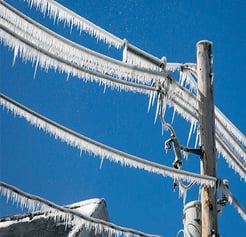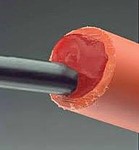What Weather Can Do To Your Fiber Optic Cables - Part 2: Ice
 With winter weather coming, you face another serious challenge: freezing temperatures, snow, sleet and ice. The change in seasons means a shift in reasons why connectivity disruptions occur. Fiber optic cables are built to withstand most cold conditions as the actual frigid temperatures are not what affects them. Seeing beyond the number on the thermometer, it’s the byproducts of the cold that causes issues.
With winter weather coming, you face another serious challenge: freezing temperatures, snow, sleet and ice. The change in seasons means a shift in reasons why connectivity disruptions occur. Fiber optic cables are built to withstand most cold conditions as the actual frigid temperatures are not what affects them. Seeing beyond the number on the thermometer, it’s the byproducts of the cold that causes issues.
Microbends
The problems begin when water has made its way into the conduit. Generally this happens when there are gaps or imperfect joins at the connectors or the connectors are simply not robust enough to avoid water ingress. Whenever water makes its way into the cables and the temperature plunges, the water freezes and ice forms around the fiber strands. The ice causes the fiber to contort and bend. These microbends will degrade the signal passing through the strands. Depending on how severe the bending is, the signals can be slowed down, reducing the bandwidth, but in other instances, signals won’t be able to pass through the fiber optics at all and leads to fiber optic networks going down without warning.
Ice Crush
In cold climates, water that penetrates a splice enclosure can freeze, and crush the fiber strands, leaving you with a costly network outage. Frozen water creates pressure upwards of 30,000 PSI. Most fiber cables will crush at a pressure of
around 6380 PSI.
So ice creates essentially five times the pressure that it takes to crush the fiber. When this ice crush occurs, an emergency network repair is required to avoid additional damage and downtime. However, given the frigid conditions, entry to the splice enclosure is often hard to reach. In some situations, it is not unusual to discover the handhole or pull box buried under a snowbank, with the lid sealed by ice, and full of water that has completely frozen solid.
How Does Water Get In?
Access Points - Conduits in a fiber optic plant have access points. Water can infiltrate at these connections and flow downhill and settle. This can lead to hundreds of gallons of water being present in the conduits. As long as the conduit is buried below the frost line, this doesn’t present a problem, as no freezing will occur. But where out of necessity a fiber optic cable is exposed to freezing temperatures, ice will develop in the duct.
Condensation - This is another culprit, chiefly at exposed bridge crossings, where differences between the ambient temperature and the inside of the conduits are common. Just as condensation forms on a cold glass, so too does condensation form inside innerducts and conduits.
Again, as long as the conduit is buried below the frost line, no freezing will result. At bridge crossings, it’s common for fiber freezing to occur two to three feet within the head wall of a bridge. Freeze-ups are similarly a problem in pipelines where they are exposed or situated on a beam or girder used in bridge construction to cross creeks or rivers.
Preventing Damage
Fortunately, there are some preventative steps available when installing your fiber optic cables to ensure that your cables are not affected and connectivity is not interrupted.
Obviously the best approach is to bury all fiber cables below the frost line, so there’s no threat of ice. Although temperatures in some states can get to -40°F, the temperature inside the conduit that’s underground will not drop below about 25°F. Unfortunately this solution can be extremely expensive and/or is economically out of the budget. In some areas, installing cables below the frost line is not even possible as when cables need to be routed along a bridge or other structure.
 Another solution is to add antifreeze liquids or gels to the fiber conduit. These specialty, antifreeze gels are injected or pumped into conduits to restrict water ingress and the subsequent ice production. They’re recommended for systems installed above the frost line such as those carrying fiber optics across bridges and other large structures. But again, this can come with a significant cost.
Another solution is to add antifreeze liquids or gels to the fiber conduit. These specialty, antifreeze gels are injected or pumped into conduits to restrict water ingress and the subsequent ice production. They’re recommended for systems installed above the frost line such as those carrying fiber optics across bridges and other large structures. But again, this can come with a significant cost.
To cost-effectively protect the fiber against severe temperatures, it’s essential to safeguard the endpoints and connections from any water leaking into the conduit, and later freezing. Connectors which are specifically designed for bitter environments can help ensure the fiber conduit is sealed, and the fiber itself is safe from the risk of ice formation.
Some providers have explored a remedy for the freezing in pipes at creeks or river crossings by laying carrier pipes along railroad rights-of-way and attaching them to the sides of any bridges or culverts or laying them on the bridge deck. This is much less costly than placing the cable underground.
When your weather service is advising you that the big blizzard is on its way, you have a lot of built-in weather advantages with a fiber plant, but even fiber is not bulletproof. Some preventative measures can add peace of mind for your fiber investment and keep your service operational.

About the Author: Marsha Hemmerich
Never miss a post.
Enter your email to subscribe:
- Ask an Expert (12)
- Blog (12)
- Technology (11)
- Hot Topics (8)
- ask a broadband expert (8)
- DOCSIS (7)
- PNM (7)
- proactive network maintenance (7)
- Industry Perspectives (5)
- BEAD (4)
- Broadband Funding (4)
- Customer Service (4)
- FCC (4)
- IIJA (4)
- PreEqualization Analyzer (4)
- correlation groups (4)
- fiber broadband (4)
- fiber optics (4)
- fiber troubleshooting (4)
- interview (4)
- CGNAT (3)
- Carrier Grade NAT (3)
- DDoS Attacks (3)
- DOCSIS pre-equalization (3)
- Diagnostics (3)
- Distributed Denial of Service Attacks (3)
- GPoN (3)
- IPv4 Conservation (3)
- Purchase IPv4 Addresses (3)
- What is DOCSIS PNM (3)
- broadband infrastructure funding (3)
- fiber (3)
- 5G (2)
- CALEA (2)
- CALEA Compliance (2)
- Codeword Errors (2)
- DOCSIS 3.1 (2)
- Distributed Access Architecture (2)
- Group Delay (2)
- ICFR (2)
- IP traffic (2)
- IPv6 migration (2)
- In Channel Frequency Response (2)
- Main Tap Compression (2)
- Marketing (2)
- Micro Reflections (2)
- Millimeter Wave (2)
- OTT (2)
- Rural Broadband (2)
- Types of DDoS Attacks (2)
- Voice Service (2)
- XGS-PON (2)
- broadband data collection (2)
- customer service (2)
- internet issues (2)
- mid-band spectrum (2)
- mmWave (2)
- network traffic (2)
- network virtualization (2)
- state broadband (2)
- state broadband program (2)
- weather-related Internet issues (2)
- 10G (1)
- BDC (1)
- BDC Availability Data Specification (1)
- BDC User Guide (1)
- BEAD Funding (1)
- Broadband Providers (1)
- Broadband Serviceable Location Fabric (1)
- Broadband Serviceable Locations (1)
- C-Band (1)
- CA Certificate Expiration (1)
- CAF II Requirements (1)
- CAF II Testing (1)
- CALEA SSI Plan (1)
- CBRS (1)
- Carpet Bombing (1)
- Citizens Broadband Radio (1)
- Communications Assistance for Law Enforcement Act (1)
- Connect America Fund (1)
- DAA (1)
- DOCSIS 4.0 (1)
- DOCSIS CA Certificate Expiration (1)
- DPoE (1)
- DPoG (1)
- EPoN (1)
- Excel Text Matching (1)
- Extended Spectrum DOCSIS (1)
- Extending HFC Life (1)
- FCC Broadband Map (1)
- FCC data (1)
- FTTH (1)
- FTTx (1)
- Fidelity Communications (1)
- Full Duplex (1)
- Greenfield Broadband (1)
- Hosted VoIP (1)
- IPTV (1)
- IPv4 (1)
- IPv6 (1)
- IPv6 Transition Plan (1)
- LTE (1)
- Low Latency DOCSIS (1)
- MAC/PHY (1)
- Mobile (1)
- Monitoring (1)
- Motivation for DDoS Attacks (1)
- Multi-Vector DDoS Attacks (1)
- NG-PON2 (1)
- NIST (1)
- NIST Cybersecurity Framework (1)
- NIST requirements (1)
- NetFlow (1)
- Network Traffic Management, (1)
- OTT video streaming (1)
- Private Access License (PAL) (1)
- RDOF Auction (1)
- RDOF Voice Requirements (1)
- Remote MAC/PHY (1)
- Remote PHY (1)
- Robocalls (1)
- Rural Broadband Network Advancement Act (1)
- Rural Digital Opportunity Fund (1)
- SSI (1)
- STIR/SHAKEN (1)
- Small Cells (1)
- Streaming (1)
- System Security and Integrity Plan (1)
- TV Viewership Analytics (1)
- TWDM-PON (1)
- TruVizion (1)
- Underserved Locations (1)
- Unserved Locations (1)
- Upstream Analyzer (1)
- Videos (1)
- VoIP (1)
- VoIP revenue (1)
- Wired Broadband (1)
- broadband data collection program (1)
- broadband deployment (1)
- broadband support (1)
- cableLabs (1)
- caf ii (1)
- case study (1)
- cloud-based VoIP (1)
- commercial VoIP (1)
- commercial VoIP revenue (1)
- cpe spectrum capture (1)
- customer service tip (1)
- cyber attacks (1)
- cybersecurity (1)
- dhcp (1)
- downstream spectrum issues (1)
- dual stack implementation (1)
- dynamic spectrum sharing (1)
- electric membership cooperatives (1)
- fiber Internet (1)
- fiber deployment (1)
- forward path monitoring (1)
- free download (1)
- full band capture (1)
- holiday customer service (1)
- holiday tech support (1)
- ingress (1)
- middle mile grant program (1)
- net neutrality (1)
- open access fiber (1)
- open access fiber network (1)
- open access networks (1)
- pppoa (1)
- pppoe (1)
- pre-equalization (1)
- reduced maintenance costs (1)
- remote spectrum analyzer (1)
- return path (1)
- scott helms (1)
- technical paper (1)
- technical support (1)
- vTDR (1)
.
About the Blog
Bloggers
Comments Policy
Guest Blogging
Privacy Policy

Leave a comment: